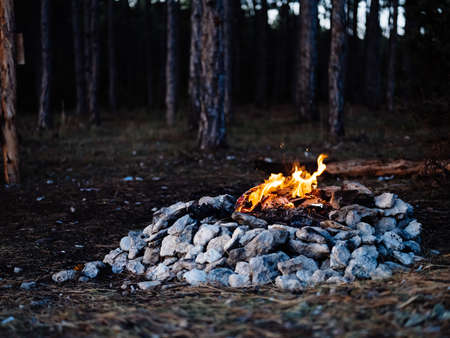Choosing the Right Site
Selecting where to build your campfire is the first and most crucial step. Many campers make the mistake of picking a spot that seems convenient, without considering safety, sustainability, or even the overall experience. A poorly chosen site can risk wildfires, damage fragile ecosystems, and ruin the atmosphere for your group and others. Always look for established fire rings or cleared areas away from trees, bushes, and tents. Avoid spots near dry grass or low-hanging branches that could catch fire easily. By choosing your site carefully, you not only protect nature but also set the tone for a safe and memorable night under the stars.
2. Fire Building Basics
Creating a great campfire starts with the basics, but even seasoned campers make mistakes in gathering kindling, stacking wood, and ensuring good airflow. These missteps can lead to frustration or unsafe fires.
Common Mistakes
| Mistake | Why It Happens | How to Avoid |
|---|---|---|
| Poor Kindling Choices | Using damp twigs or skipping small tinder entirely. | Always gather dry, thin sticks and natural tinder like pine needles before starting your fire. |
| Improper Wood Stacking | Piling logs randomly or too tightly together. | Use a teepee or log cabin structure to allow flames to spread and air to circulate. |
| Restricted Airflow | Smothering the fire by adding too much wood at once. | Add wood gradually and leave space between logs for oxygen to fuel the flames. |
Pro Tip:
Practice building small fires first. Focus on learning how each material burns and how to adjust your setup for changing wind or moisture conditions. Mastering the basics keeps your campfire safe and sustainable.
![]()
3. Fire Safety Must-Knows
Campfire safety is the heart of responsible outdoor living. Every campfire should begin with awareness—know local fire bans and regulations before you strike a match. Always build your fire in established rings or pits, away from brush, low-hanging branches, and tents. Clear a wide area down to bare soil, removing leaves and pine needles that can catch sparks. Keep your fire small; it’s easier to manage and less likely to get out of control. Never leave a campfire unattended, not even for a minute. Appoint someone as the designated “fire watcher.” Always have water and a shovel nearby to put out unexpected flames fast. When it’s time to leave or sleep, drown your fire thoroughly with water, stir the ashes, then feel for heat with the back of your hand—if it’s too hot to touch, it’s too hot to leave. These habits protect both you and the wild places we cherish.
4. Leave No Trace Principles
When it comes to enjoying campfires, following Leave No Trace principles is not just a suggestion—its a responsibility. The natural world is a shared space, and every camper’s actions leave an impact. One of the most common mistakes is neglecting to clean up after a campfire. This can mean leftover ashes, unburned wood, or even trash left behind. Such remnants not only harm wildlife but also spoil the experience for future visitors.
Why Clean Up Matters
Cleaning up after your fire ensures that nature stays as pristine as you found it. It prevents animals from ingesting harmful materials and keeps campgrounds safe for everyone. Remember, what you pack in, you must pack out—even small things like bottle caps or food wrappers.
Campfire Clean-Up Checklist
| Task | Why Its Important |
|---|---|
| Extinguish fire completely | Prevents wildfires and protects habitats |
| Scatter cool ashes | Ashes blend with the earth and reduce visual impact |
| Remove all trash and food scraps | Keeps wildlife healthy and environment clean |
| Dismantle fire rings (if allowed) | Restores natural appearance of campsite |
Respecting Nature Is Key
By respecting these principles, you help preserve America’s wild spaces for generations to come. Simple habits—like double-checking your site before leaving—make a big difference. Campfire mistakes are easy to avoid when we all commit to being mindful stewards of the outdoors.
5. Engaging the Campfire Community
Sitting around a campfire is about more than warmth and light—its an invitation to connect. Avoid the mistake of treating the campfire as just another chore. Instead, turn it into a shared experience.
How to Enjoy Campfire Moments Together
Gather close. Arrange your chairs in a circle to encourage conversation. Keep your devices away and let nature be the backdrop. Take turns tending the fire so everyone feels involved and responsible.
Share Stories
Storytelling is a timeless campfire tradition. Invite everyone to share—a childhood memory, a funny camping mishap, or even a local legend. Don’t worry about perfection; authenticity brings people together.
Nurture Connection
Foster openness by listening without judgment. Use the fire’s glow as an opportunity for meaningful conversations. Singing songs, playing simple games, or sharing s’mores recipes can deepen bonds. When each person feels seen and heard, the campfire becomes the heart of your campsite community.


